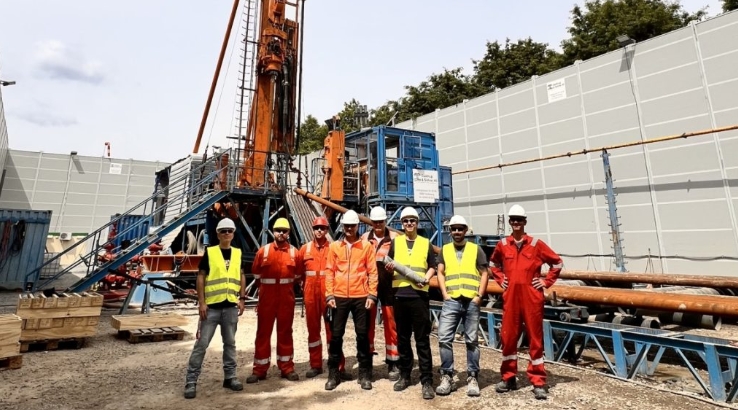
Drilling team in front of the rig at the site of the research borehole in Krefeld, GermanY
The drilling, which began in March 2025, lasted 73 consecutive days and reached a final depth of 957 meters. The target was the Kohlenkalk formation, a limestone unit from the Carboniferous period. This formation was encountered at a depth of 380 meters and continued to 944 meters—far deeper than the originally projected base depth of 725 meters. The thicker-than-expected limestone layer suggests enhanced geothermal potential at the site.
In total, around 667 meters of core samples were extracted from the well. These samples are currently undergoing detailed analysis to better understand the reservoir properties and geological history of the formation. Project leader Ingo Schäfer stated: “They tell us a lot about the carbon limestone, its reservoir properties, and the geological processes that formed it. The new findings are applicable to the entire region—and this is precisely the information we need to professionally assess the potential for the safe and sustainable use of deep geothermal energy.”
Hydraulic testing also yielded positive outcomes, indicating that the borehole can deliver higher water yields than originally estimated. This reinforces the site’s suitability for potential future geothermal use, though further analysis is ongoing.
The Krefeld drilling project is part of the broader “Geowärme – Wir erkunden NRW” initiative, aligned with the NRW Geothermal Master Plan introduced in 2024 by the Ministry of Economic Affairs, Industry, Climate Protection and Energy of the State of North Rhine-Westphalia. The initiative aims to explore deep geothermal reservoirs throughout the region to meet up to 20% of the state's heating demand through environmentally friendly sources by 2045.
The Geological Survey of North Rhine-Westphalia (GD NRW), which oversees the program, has announced that the next geothermal drilling will be conducted in early 2026 in Cologne-Dellbrück.
As the Krefeld well was drilled solely for research under state authority, it is not intended for commercial operation. Since it does not meet the technical and regulatory standards required for long-term energy production, the well will be securely backfilled according to official procedures. The entire drilling site, temporarily set up in a parking area, will be dismantled, and the parking space will be fully restored for public use.